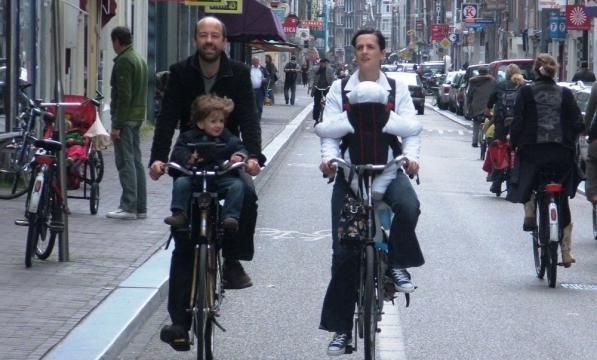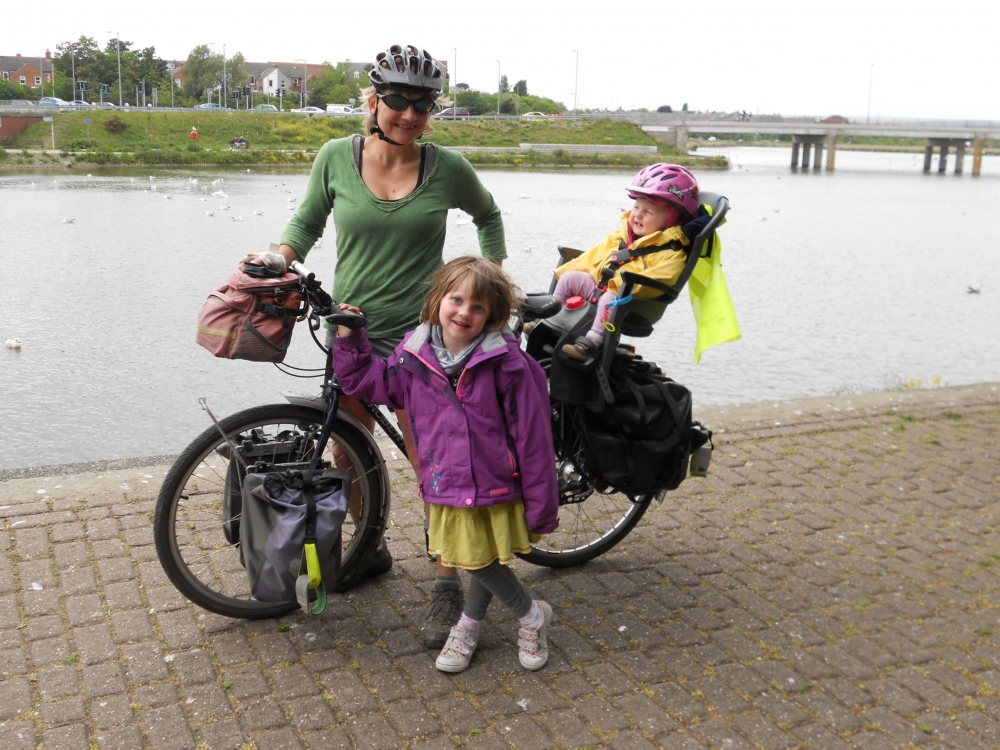Front child seats

The attractions of a front seat are obvious. The child is right there, sees all that you see, sharing the experience of cycling in a far more intimate and stimulating way than when seated behind your bum. In front, they may even seem more protected, sheltered between your arms. You could grab and protect the child if anything bad happens, right? Wrong! The same was said of the now illegal practice of sitting a child on your lap in a car. But we must keep a sense of proportion. Cycling speeds are much slower than driving speeds and with each halving of speed, kinetic energy is quartered. The likely consequences of a cycling collision, regardless of seating arrangement, are therefore an order of magnitude lower than the dangers to which an unrestrained car occupant is exposed. Bicycle child seats moreover, are equipped with restraints, so ejection is unlikely.
On a bike, it's the adult who is unrestrained, and that's the special danger to which a front-seated child is exposed. Whilst a rear seated child is obviously imperilled by a rear collision, these are extremely rare in comparison to frontal cycling crashes. Such crashes have many causes: motor vehicles pulling into a cyclist’s path, oncoming cycles on twisty narrow bikepaths, potholes and other obstructions, or the rider’s own lack of judgement and control. Given the low speed of a bicycle, the consequences of these commonplace events are usually not too serious, but are magnified for an infant trapped between an adult with momentum and the object or surface collided with.
The addition of a front seat to a bicycle also makes such collisions more likely. Bicycles, due to their high centre of gravity compared to wheelbase, already have a greater tendency to tip over forwards and hence need further to stop than other vehicles (at the same speed). Adding mass in front of the rider shifts the centre of gravity forward, making the bike even more likely to tip over, or fail to stop before colliding! A rear seat on the other hand (provided the bike has effective brakes), adds ballast to improve stopping performance. So if the bike already has a child on the back, there’s both a stronger reason for and less reason against adding a front seat.
In the Netherlands, where front child seats are more commonly used than in any other country, they are mostly used in addition to a rear seat. And Dutch city bikes have a couple of other attributes which equip them for a front seat. Their long wheelbase, shallow seat angle and upright riding position shifts the centre of gravity rearwards – for safer stopping with less risk of tip-over.
Being more upright also keeps the rider’s body clear of the back of the seat, which is usually attached to the handlebars and fork, so it swings with the steering, so incidental contact with the rider’s body hinders control of the bike. (Hence front seats are not allowed in Germany unless they’re attached to the frame.)
Dutch city bikes also have swept-back handlebars (like everyday bikes used to have everywhere else, before we lost and forgot our everyday cycling traditions!) which bring the handgrips much closer to the rider and clear of any front-mounted seat. It also has to be acknowledged that the Dutch cyclepath and legal systems ensure that a cyclist can mostly keep rolling, with little risk of collision or an unexpected stop. Only in the Netherlands is it both safe enough and legal to ride a bike with no front brake!
The advocates of front seats will counter with the scary run-down-from-behind scenario! Both adult and child are likely to be seriously injured of course, even if the child is in front. And we most fear that which we cannot control, so it’s natural for a cyclist to worry about being hit from behind. Thankfully such events are very rare – except on high-speed main roads.
These factors were discussed at length by the international panel of experts tasked with drafting EN14344, the European Standard for Child Seats for Cycles. We also consulted such data as could be found regarding the accidents and injuries suffered by cycle child seat passengers. There wasn’t a lot, which is probably a good thing, but is also because the recording of crash details by hospital staff (police are seldom called to incidents that don’t involve motor vehicles) is poor.
There was evidence nevertheless, that the sort of incidents one might predict with front seats do occur, but not enough to justify their prohibition in the face of the needs of parents with more than one child to transport, and the general benefits of cycling. There was a lot of very earnest discussion between the Netherlands and Germany on the relative disadvantages of fitting front seats to the frame or the handlebar. Both options remain in the Standard, which nevertheless requires an extra warning that front seats reduce the manoeuvrability of the bicycle. Rear collisions do not emerge as a serious problem in child seat incident data. I think this is probably because parents don’t take their children cycling on high-speed main roads.
So now perhaps you can understand why our page on choosing a child seat tends to encourage the use of a rear child seat in preference to the frontal variety and recommends a trailer when two children must be transported. If you already have a long wheelbase bicycle however, with a bolt-upright riding position and swept back handlebars, and are fortunate to inhabit a neighbourhood with Dutch-like cycling conditions, seats both front and rear is another good solution.
Chris Juden is a former Senior Technical Officer at Cycling UK, he is an engineer and has over 40 years experience working in cycling. This is his personal view about front seats.


